The Robotic Operating System at a Glance
Introduction, Showcases, Demonstration and Perspectives.

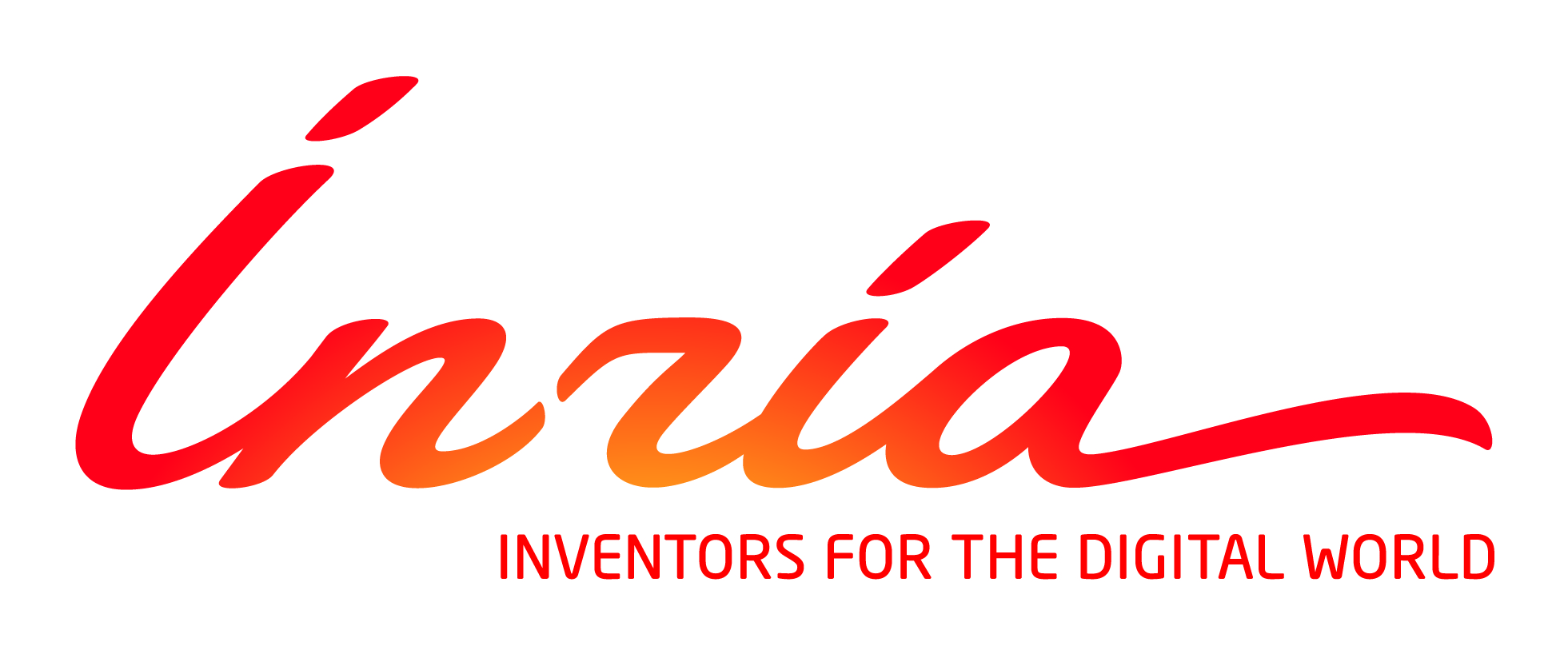
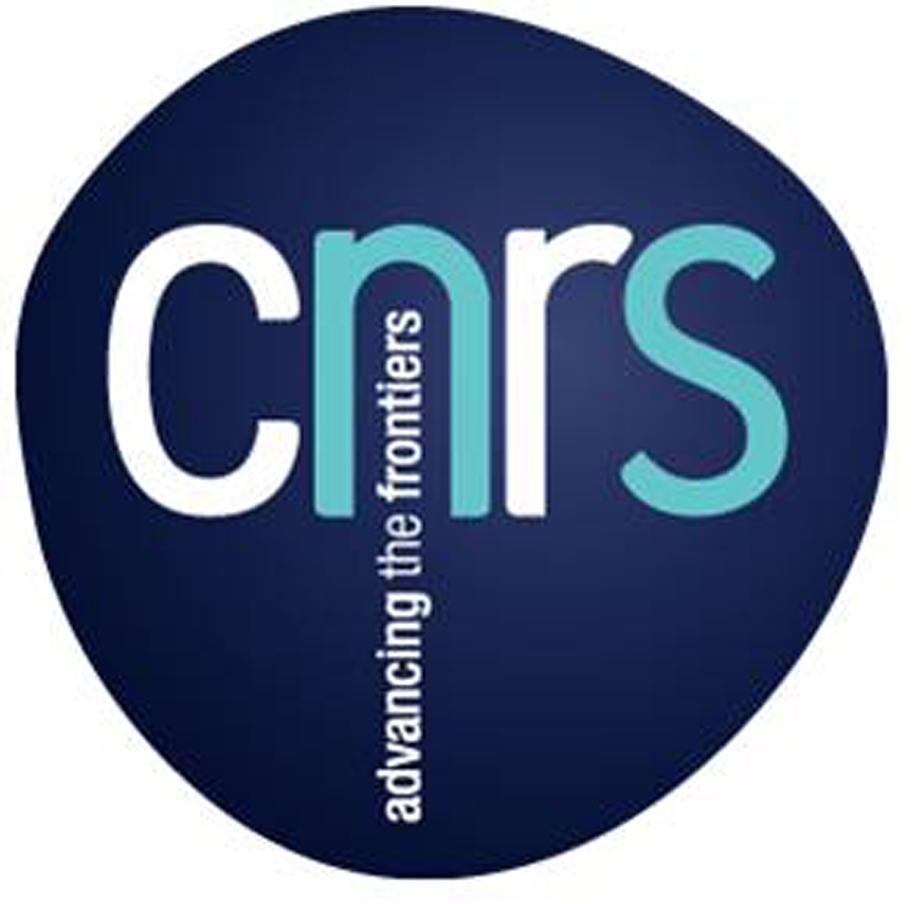
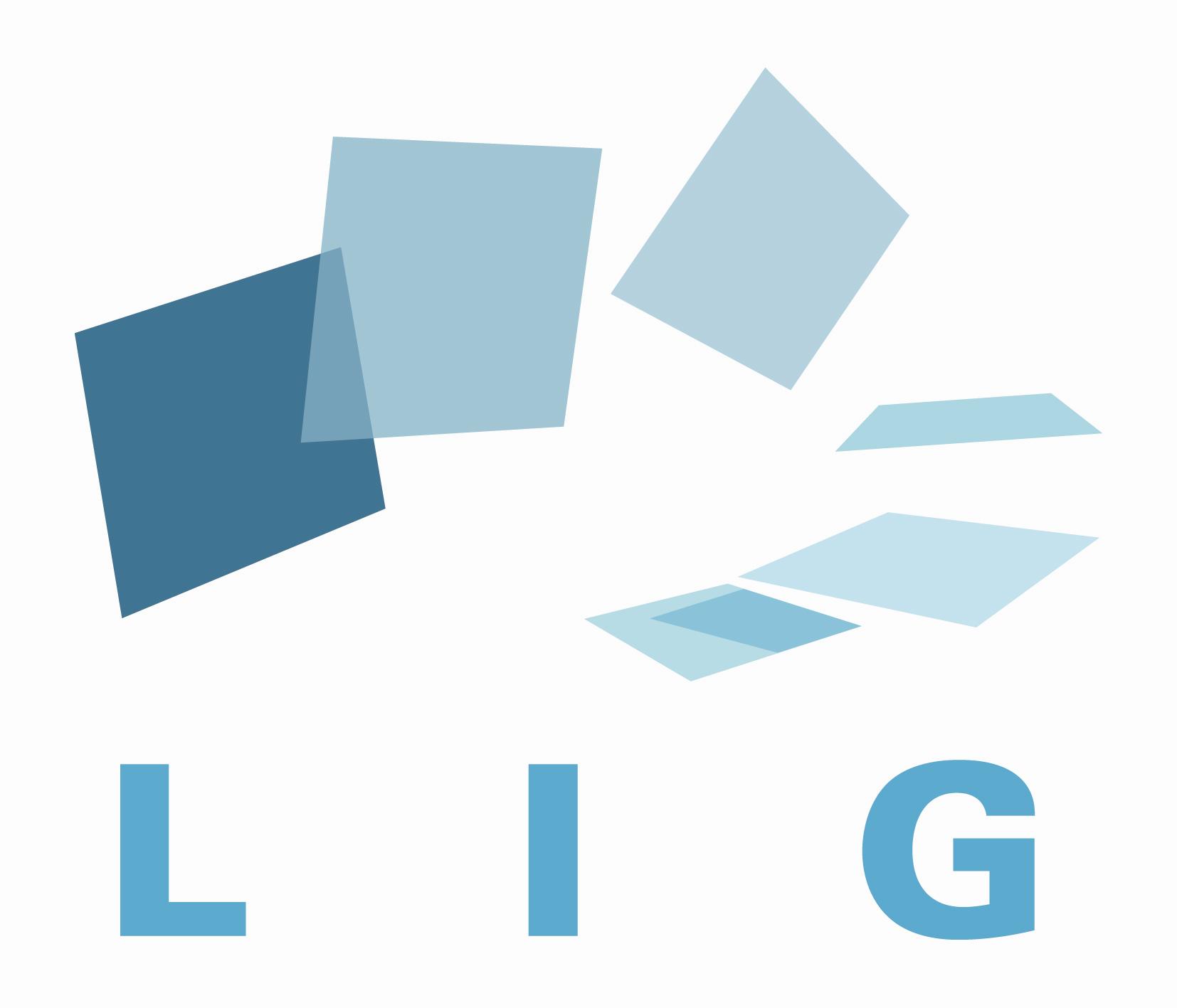
<HTML5> presentation realized with deck.js and hosted on github
this is an HTML5 presentation realized with the open source framework deck.js and deck.ext.js
this presentation is hosted on Github at https://github.com/barraq/fOSSa2012
this presentation is served by Github at http://barraq.github.com/fOSSa2012/slides.html


Presentation Overview
- Introduction to ROS
- Motivation for ROS
- What is (not) ROS
- ROS Concept
- ROS Tools
- Getting Started with ROS
- C++
- Python
- Java
- Show Cases
- Personally Assisted Living
- Perception for on road vehicle
- Robot Prototyping
- Conclusion and Perspectives
- Live Demonstration
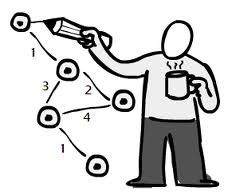
What are the motivations for a common robotic infrastructure?
Introduction to ROS
Motivation for ROS
A Robot is a composition of different components
- Hardware components
- Computational Units (FPGA, PC, Microcontroller, …)
- Actuators (Motor, …)
- Sensors (Camera, IR, LIDAR, …)
- Software components
- Hardware drivers
- Robot servoing
- Perception
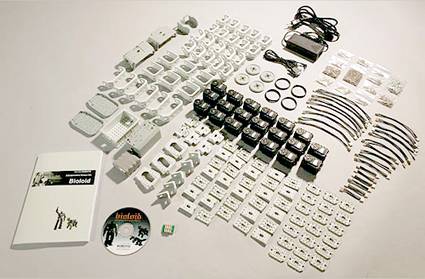
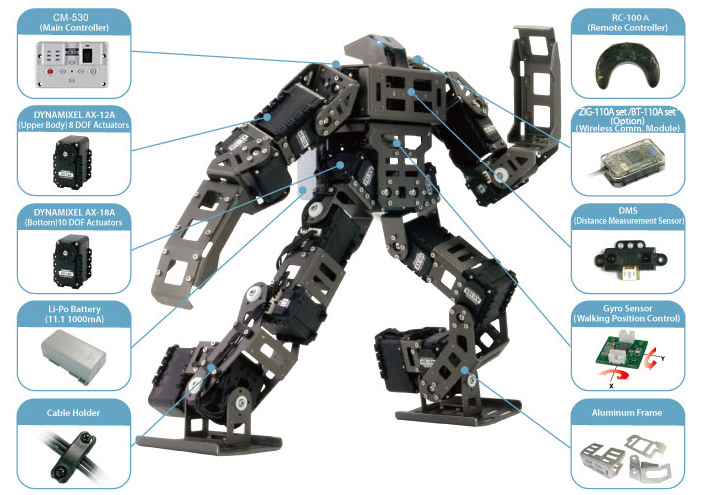
A Robotic application is an interconnection of components
- Heterogenous components
- Cross-language
- Cross-platform
- Distributed components
- Multi-robots
- Multi-PC
- Multi-network
- Dynamic components
- Appear, Disappear (mobility)
- Crash, Evolve
Both Robots and a Robotic Applications are an assemblage of many other people's components
⇒ Need for a common Robotic Operating System

What is ROS?
What is (not) ROS
ROS is a 'Meta' Operating System for Robotics Applications
- An open source robotics framework
- Maintained by Willow Garage (PR2, TurtleBot, ROS, OpenCV, PCL, …)
- Cross-platform (Ubuntu, OSx, Windows, Android, …)
- Cross-language (C/C++, Python, Java, …)
- An architecture for distributed inter-process/inter-machine communication and configuration
- Object like message wrapping/unwrapping
- Message passing (Publisher/Subscriber, RPC)
- Graph node communication with master node
- Centralized configuration
- A collection of tools
- packaging, dependency/build management, shell introspection, …
- runtime tools, data analysis, graphic user interfaces, …
- A Large community with thousand (and counting) existing modules
What ROS is not?
- Not an operating system, instead runs on
- Ubuntu (official)
- Windows, OS X, Fedora, Android (experimental)
- Not a programming language
- C++, Python (official)
- Java+Android, Octave, … (experimental)
- Not a programming environment but a programming toolkit
- Not a hard real time architecture
- Not designed for embedded systems (refer to rosserial)
ROS Concepts
ROS Concepts
A ROS application is a graph of nodes
- Node = a process that used the ROS framework
- Different Nodes may reside in the same or different machines transparently
- Nodes get to know one another via rosmaster
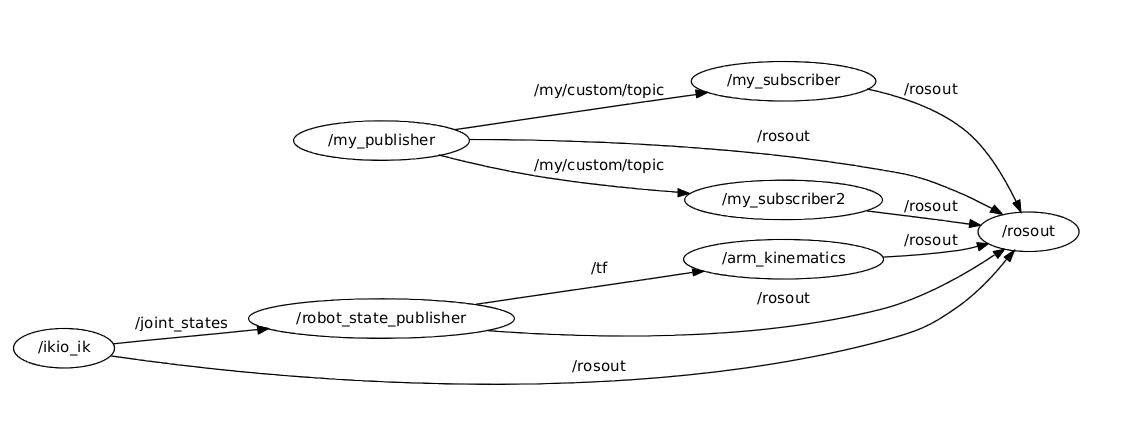
Nodes in this graph communicate using two protocols
- Topics
- asynchronous,
- data flow, message passing,
- typed by a Ros Message (message.msg);
- Services
- synchronous,
- remote procedure call (Request --- Answer messages),
- typed by a Ros Service (service.srv);
Messages & Services are statically defined
$ rosmsg show knx_control/KNXDataPoint
string name
string address
string dptID
string priority
bool stateBased
int32 mainNumber$ rossrv show knx_control/SetDataPoint
string address
string value
---
string value
- Directory used for topics discovery : ROS Master;
- Multiple concurrent publishers / subscribers for a single topic;
- Publish / subscribe order irrelevant.
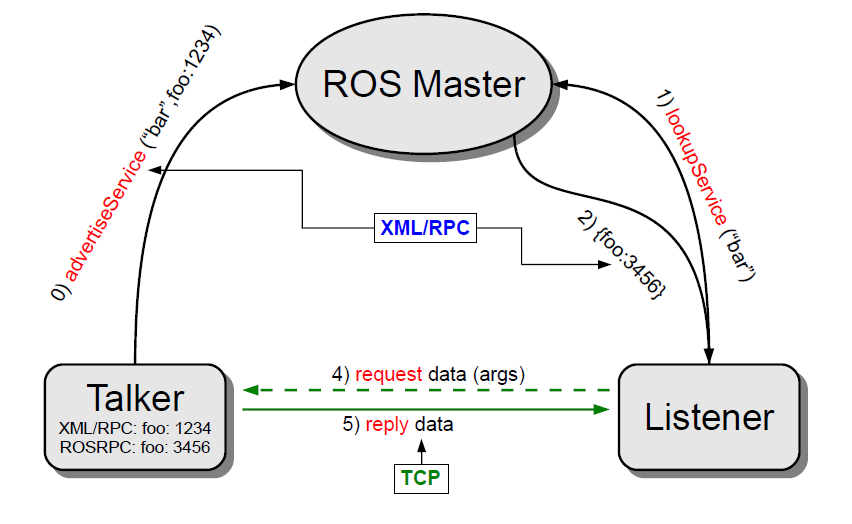
- Directory used for service discovery : ROS Master;
- Multiple simultaneous clients.
Roscore = rosmaster + parameter server + log aggregator
Rosmaster
- directory for publisher / subscribers / services,
- XMLRPC API,
- not a central communication node.
Parameter server
- centralized parameter repository,
- provides parameter access to all nodes,
- XMLRPC data type.
Log aggregator
- subscribes to /out topic,
- store output on filesystem.
Automate startup of complex ROS applications.
Launch files are XML files specifying :
- list of nodes,
- with topics / service remapping,
- parameter values,
- machines for distributed applications.
<launch>
<include file="$(find ikio)/launch/ikio.launch"/>
<node pkg="tf" type="static_transform_publisher"
name="base_link_to_cam"
args="1 0 1.3 3.14 0 0 base_link camera_link 10" />
<arg name="marker_size" default="8" />
<node name="ar_track_alvar" pkg="ar_track_alvar" type="individualMarkers" respawn="false" output="screen" args="$(arg marker_size) " />
<node name="ar_to_pose" pkg="ikio" type="ar_to_pose" output="screen"/>
</launch>Ros code is grouped at two different levels
Packages
- atomic unit of building,
- can contain anything : nodes, messages, tools, launch files, etc.
- in their most basic form :
- package_name
- package_name/Makefile
- package_name/CMakeLists.txt
- package_name/manifest.xml
Stacks
- atomic unit of "releasing",
- collection of packages for distribution,
- in their most basic form :
- stack_name
- stack_name/package_name_1
- stack_name/package_name_n
- stack_name/stack.xml
ROS Tools
ROS Tools
- rosnode list nodes and interconnections,
- rxgraph display connection graph
 Message Introspection
Message Introspection
- rostopic list topics, print message information, echo messages
- rosservice list services, call services, print service information
- different verbosity levels (info, debug, error, etc.),
- published on an unique topic /rosout,
- rxconsole for online inspection,
- automatic dumping to file system for offline analysis.

- full 3D visualization,
- display almost all standard sensor messages and frames,
- plugin system to handle build-in messages.
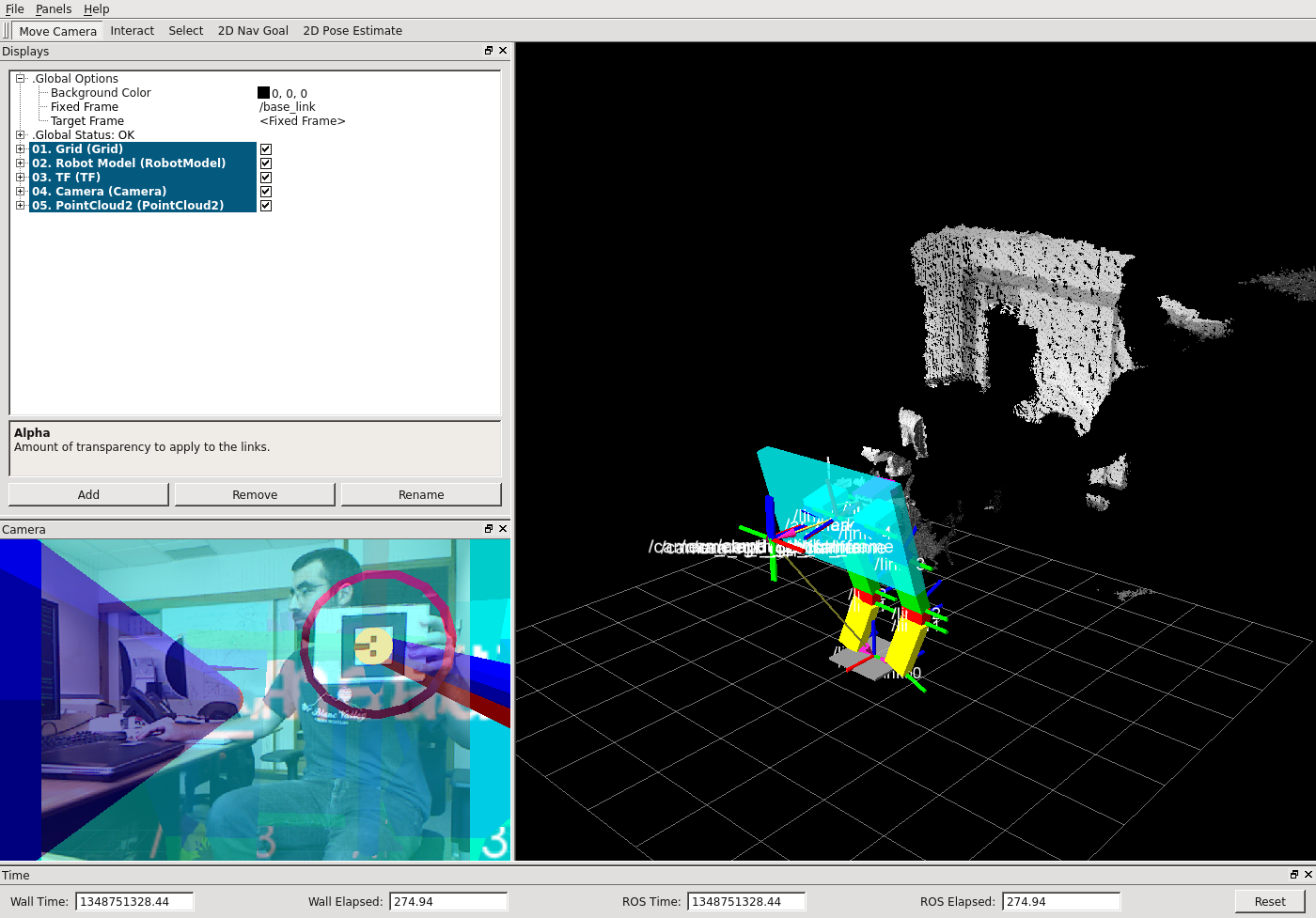
- rosbag record : generic subscriber,
- container : bagfile,
- rosbag play : generic publisher,
- rxbag : graphic interface.
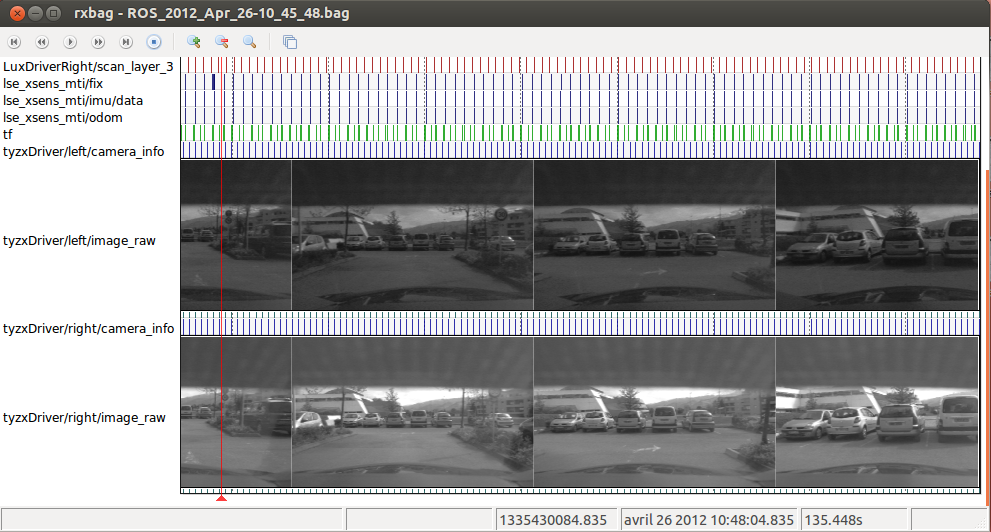
Robot
- set of rigit bodies linked together;
- each sensor obtain measurements in its local reference.
In ROS
- set of Transformation Frames,
- linked by transformations,
- organized in a directed tree,
- published on a single topic /tf,
- each sensor data is associated to a frame.
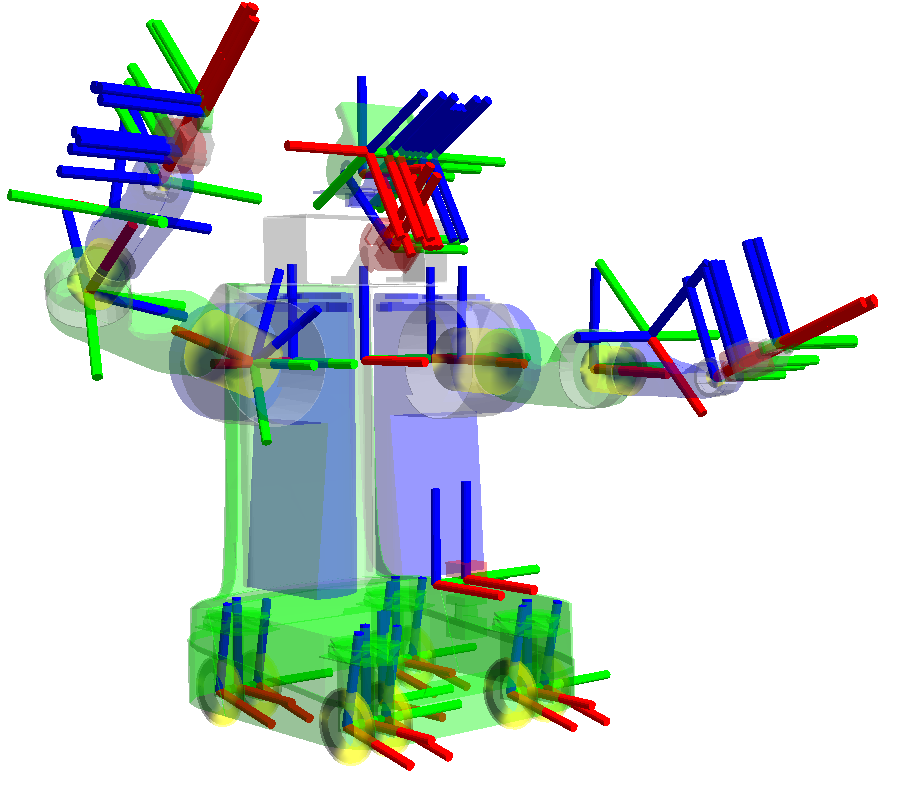
- sensors : almost all common used robotics sensors,
- robots : depends on constructors.
- SLAM (localization and mapping),
- navigation,
- 3D perception,
- simulation;
... and see a lot more during the demo session!
Getting Started with ROS
- Introduction to ROS
- Getting Started with ROS
- Create a New Package
- Create a New Message Type
- Publisher/Subscriber in C++
- Publisher/Subscriber in Python
- Publisher/Subscriber in Java
- Showcases
- Personally Assisted Living Application
- On Road Vehicle Application
- Prototyping Robots
- Conclusion and Perspectives
- Live Demonstration

Create a New Package
Create a New Package
- Head to your ROS workspace
$ roscd - Create an empty package :
$ roscreate-pkg pkg_name - Edit pkg_name/manifest.xml :
<package> <description brief="pkg_name"> My package description </description> <author>Mr Bob</author> <license>BSD</license> <review status="unreviewed" notes=""/> <url>http://ros.org/wiki/pkg_name</url> <depend package="geometry_msgs/Twist" /> </package>
Create a New Message Type
Create a New Message Type
In ROS msg and srv types definition are stored respectively in pkg_name/msg and pkg_name/srv
- Create the msg/Custom.msg file
# this is some custom message string someText uint8 someNumber geometry_msgs/Twist[] someTwistArray
Basic data types are:
- int{8,16,32,64}
- float{32,64}
- string
- time
- duration
- array[]
Packages type:
- pkg_name/type_name
- pkg_name/type_name[]
Publisher/Subscriber in C++
Publisher/Subscriber in C++
ROS uses CMake and provides a rosmake command utility
- Add roscpp dependency in the manifest.xml :
<depend package="roscpp" /> - Edit pkg_name/CMakeLists.txt
#uncomment if you have defined messages rosbuild_genmsg() #uncomment if you have defined services #rosbuild_gensrv() #common commands for building c++ executables and libraries rosbuild_add_executable(my_publisher src/my_publisher.cpp) rosbuild_add_executable(my_subscriber src/my_subscriber.cpp)
#include "ros/ros.h"
#include "pkg_name/Custom.h"
int main(int argc, char **argv) {
ros::init(argc, argv, "my_publisher"); // init ROS
ros::NodeHandle n; // handle to create publisher, subscriber, services, etc.
ros::Publisher pub = n.advertise("my/custom/topic", 1000); // create publisher
pkg_name::Custom custom_msg; // Message to be sent
ros::Rate loop_rate(10); // synchronization rate (set at 10 Hz)
while (ros::ok()){
custom_msg.someText="some text";
point_pub.publish(custom_msg); // send the message
ros::spinOnce(); // manage ros events
loop_rate.sleep();
}
return 0;
} #include "ros/ros.h"
#include "pkg_name/Custom.h"
void msgCallback(const pkg_name::Custom::ConstPtr& msg) {
ROS_INFO("My custom text : %s", msg->someText.c_str() );
}
int main(int argc, char **argv) {
ros::init(argc, argv, "my_subscriber"); // init ROS
ros::NodeHandle n;
ros::Subscriber sub = n.subscribe("my/custom/topic", 1000, msgCallback);
ros::spin(); // ROS spin loop
return 0;
}- Build the package
$ rosmake pkg_name - Run roscore
$ roscore& - Run publisher
$ rosrun pkg_name my_publisher - Run subscriber
$ rosrun pkg_name my_subscriber [ INFO] [1354267632.389733464]: My custom text : some text [ INFO] [1354267632.489738852]: My custom text : some text
Publisher/Subscriber in Python
Publisher/Subscriber in Python
- Create a directory in pkg_name to put your nodes in e.g. pkg_name/nodes
- Create the nodes/publisher.py file
#!/usr/bin/env python import rospy; roslib; roslib.load_manifest('pkg_name') from pkg_name.msg import Custom def publisher(): pub = rospy.Publisher('my/custom/topic', Custom) rospy.init_node('publisher') while not rospy.is_shutdown(): m = Custom(someText = "some text") pub.publish(m) rospy.sleep(1.0) if __name__ == '__main__': try: publisher() except rospy.ROSInterruptException: pass
- Create the nodes/subscriber.py file
#!/usr/bin/env python import rospy; roslib; roslib.load_manifest('pkg_name') from pkg_name.msg import Custom def callback(data): rospy.loginfo(rospy.get_name() + ": I heard %s" % data.someText) def subscriber(): rospy.init_node('listener', anonymous=True) rospy.Subscriber("my/custom/topic", Custom, callback) rospy.spin() if __name__ == '__main__': subscriber()
- Make both nodes executable
$ chmod +x nodes/*.py - Build the package (only for the msgs)
$ rosmake pkg_name - Run roscore
$ roscore - Run the nodes
$ rosrun pkg_name publisher.py
$ rosrun pkg_name listener.py
Publisher/Subscriber in Java
Publisher/Subscriber in Java
ROS for Java is not yet officially supported
- Old JNI API http://www.ros.org/wiki/rosjava_jni (deprecated)
- New Java only implementation http://rosjava.googlecode.com
Developed at Google in cooperation with Willow Garage
ROS for Java is slightly different
- Uses an alternative build system Gradle
- Revisited API (take benefit of Java language, asynchronous)
- More threads, fewer processes (Java Node ≡ C++ Nodelets)
ROS for Java is android friendly
- Uses the same API
- Provides additional classes (ROSActivity, Views, …)
- … but still in an alpha mode
- Create a build.gradle file (see build.gradle example) in pkg_name directory
- Add a custom task in build.gradle for better integration with rosrun
... // create a standard binary in /bin for rosrun task deployApp(dependsOn: 'installApp') << { File binDir = new File(project.projectDir, '/bin') if (!binDir.isDirectory()) { println "Creating $binDir directory" binDir.mkdirs() } File link = new File(binDir,"execute") File target = new File(project.projectDir, "build/install/$project.name/bin/$project.name") println "Creating symlink from $link.absolutePath to $target.absolutePath" ant.symlink(link: link.absolutePath, resource: target.absolutePath) } ...
- Put your your Java sources in src/main/java and your tests in src/test/java
- Implement a Node
import org.ros.namespace.GraphName; import org.ros.node.Node; import org.ros.node.NodeMain; public class MyNode implements NodeMain { public GraphName getDefaultNodeName() { return new GraphName("my_node"); } public void onStart(ConnectedNode node) {} public void onShutdown(Node node) {} public void onShutdownComplete(Node node) {} public void onError(Node node, Throwable throwable) {} }
public class Publisher extends AbstractNodeMain {
public GraphName getDefaultNodeName() {
return new GraphName("publisher");
}
public void onStart(final ConnectedNode connectedNode) {
final Publisher<pkg_name.Custom> publisher = connectedNode.newPublisher(
"my/custom/topic", pkg_name.Custom._TYPE);
connectedNode.executeCancellableLoop(new CancellableLoop() {
protected void setup() {}
protected void loop() throws InterruptedException {
pkg_name.Custom msg = publisher.newMessage();
msg.setSomeText("Hello world!");
publisher.publish(msg);
Thread.sleep(1000);
}
});
}
}
public class Subscriber extends AbstractNodeMain {
public GraphName getDefaultNodeName() {
return new GraphName("listener");
}
public void onStart(ConnectedNode connectedNode) {
final Log log = connectedNode.getLog();
Subscriber<pkg_name.Custom> subscriber = connectedNode.newSubscriber(
"my/custom/topic", pkg_name.Custom._TYPE);
subscriber.addMessageListener(new MessageListener<pkg_name.Custom>() {
public void onNewMessage(pkg_name.Custom message) {
log.info("I heard: \"" + message.getSomeText() + "\"");
}
});
}
}- Rebuild and redeploy rosjava (to build java classes/interfaces for msgs and srvs)
$ roscd rosjava_core $ ./gradlew install - Head back to you package and build it
$ roscd pkg_name
$ rosmake pkg_name
$ gradle build - Run roscore
$ roscore - Run the nodes
$ rosrun pkg_name execute your.package.path.Publisher $ rosrun pkg_name execute your.package.path.Subscriber
Showcases
- Introduction to ROS
- Getting Started with ROS
- Showcases
- Using ROS for Personally Assisted Living Application
- Using ROS for On Road Vehicle Application
- Using ROS for Prototyping Robots
- Conclusion and Perspectives
- Live Demonstration

Using ROS for Personally Assisted Living Applications
Personally Assisted Living Application
focusing on the INRIA Large Scale Initiative Action on Personally Assisted Living (http://pal.inria.fr)
Development of technologies that can provide services for improving the quality of life for elderly and fragile persons, as well as their immediate family, caregivers and social groups
- Heterogenous, distributed and mobile platforms and technologies
- Multi-site (medical team, families, caregivers, …);
- Smart spaces (Sensors/Actuators, KNX, Zigbee, Bluetooth, Wireless, …)
- Medical and healthcare devices (diagnostic, mobility, assistance, …)
- Personal and assistance robots (social interaction, physical and cognitive entertainment)
- Realtime and distributed processing
- Dynamic and constantly evolving technologies
- Recording Terabytes of data for medical and scientific experimentations/diagnostics
- Collaborative initiative
- Experimental infrastructure
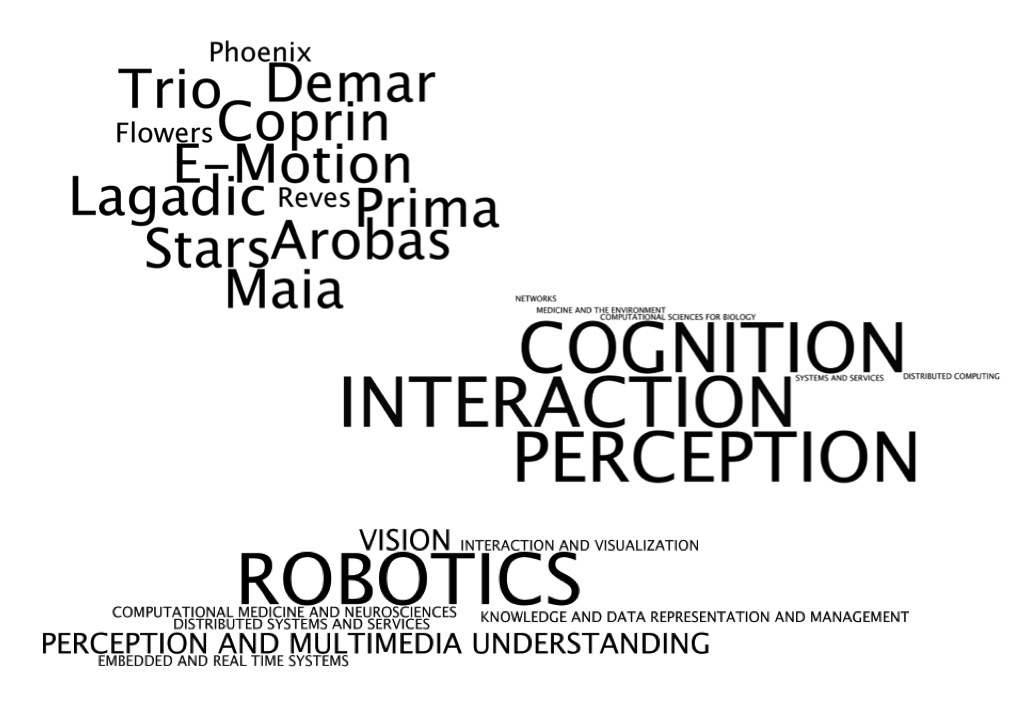
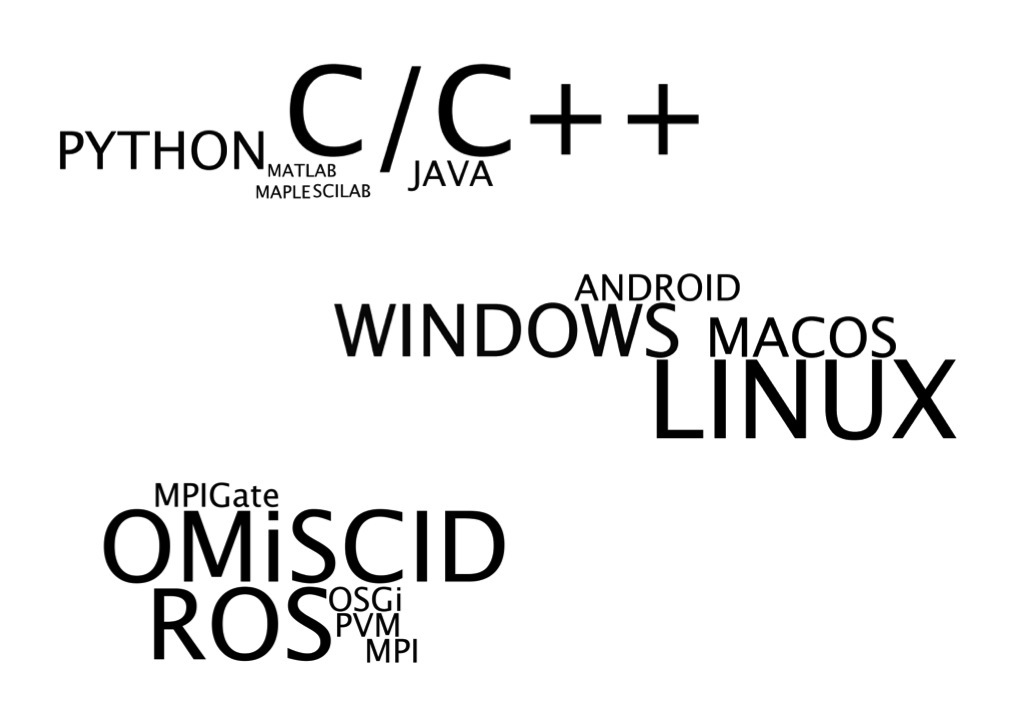
Each team/partner is an ecosystem characterized by
- its knowledge e.g. "software culture"
- its resources and tools e.g. engineers, experimental platforms, etc…
- its competences and approaches e.g. fields/themes for research, etc…
- its habits Windows/Linux, Java/C++, etc…
- its needs and constraints e.g. Real Time, Reliability, Mobility, Heterogeneity, etc…
Find an ecologic and a pragmatic solution
- easy to use e.g. minimum configuration, use friendly API, …
- non intrusive e.g. few lines of code, …
- cross platforms/language
- reliable, efficient and maintained
- widely accepted e.g. used by each partners, with exiting community …
- target for PAL i.e. not more not less
A Gate is a concept
- is an ecologic and hermetic interface between different ecosystems
- is a view of an ecosystem
- is characterized by a set of functionalities
- is provided/deployed by each partners
- publishes/subscribes information to/from other gates
- propagates information to/from its ecosystem
- provides types and means used for its communication

PALGate is an implementation of gate for PAL based on ROS
- is a ROS Stack
- provides a set of conventions (stack organization, package/node/topic/service names, namespaces, …)
- composed of Gate's types ROS package
- provides dedicated command line utilities
- provides dedicated web interface
a Gate in PALGate
- provides a msg package
- provides a srv package
- starts ROS nodes which subscribe/publish to ROS topics, register/provide ROS services in a normalized namespace
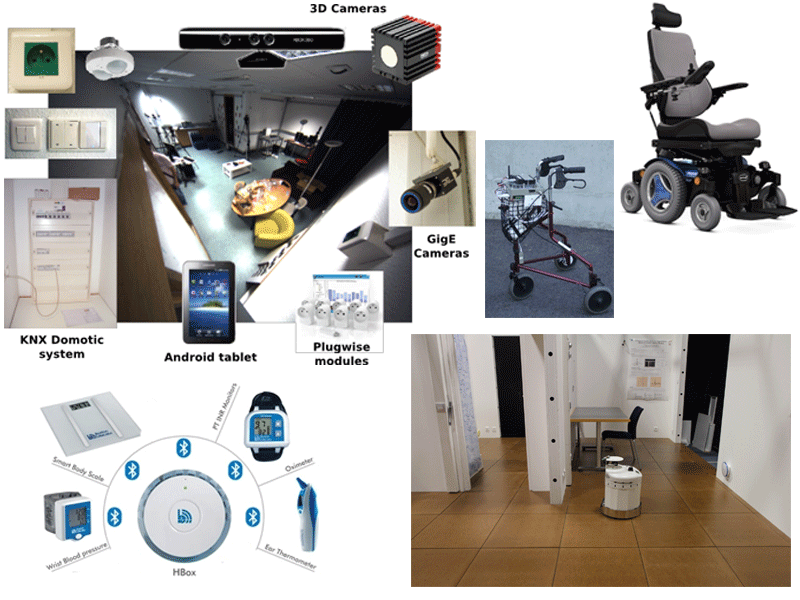

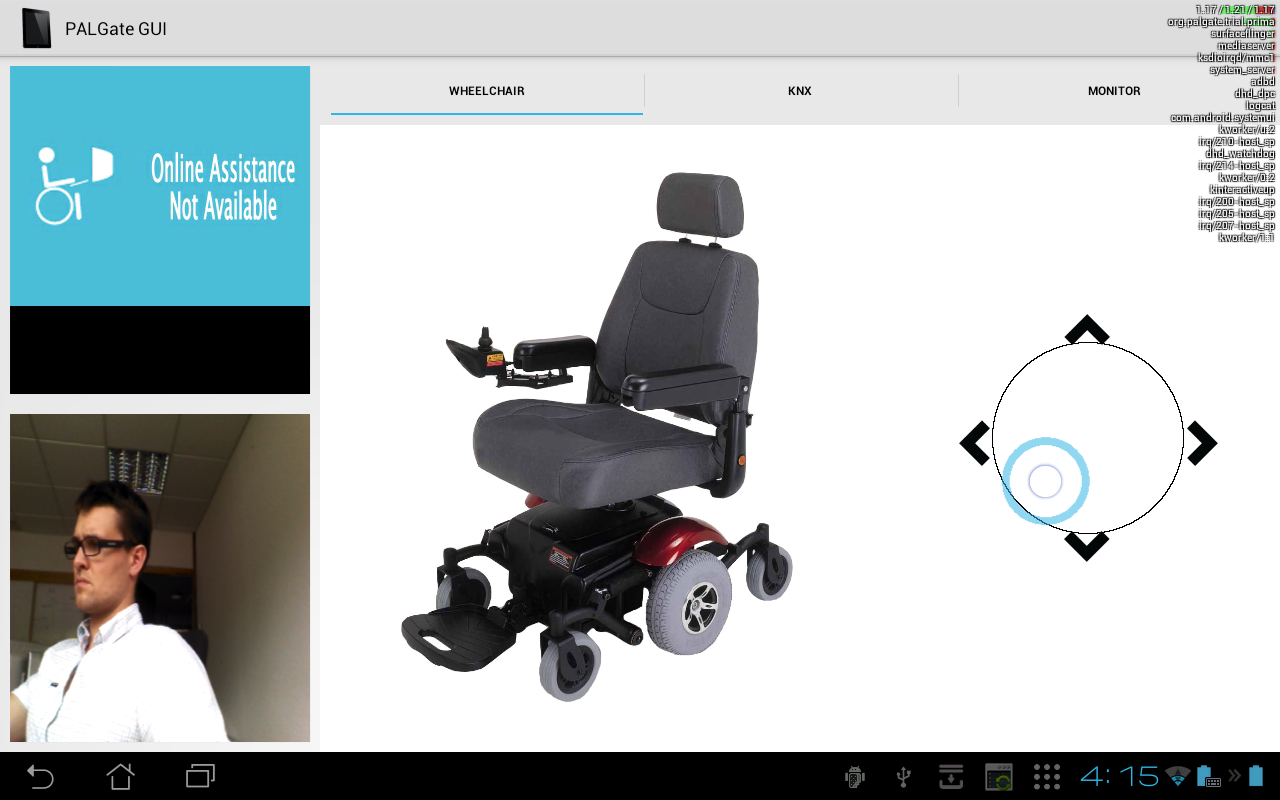
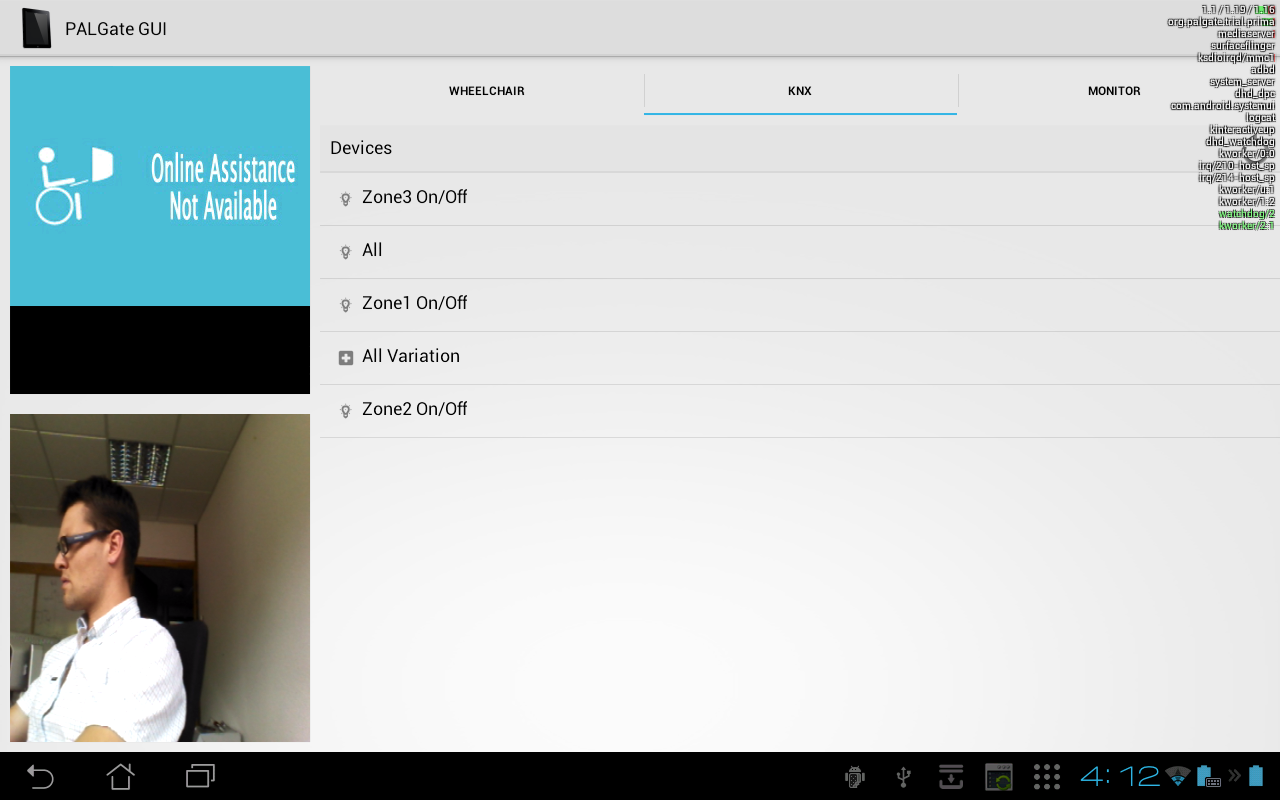
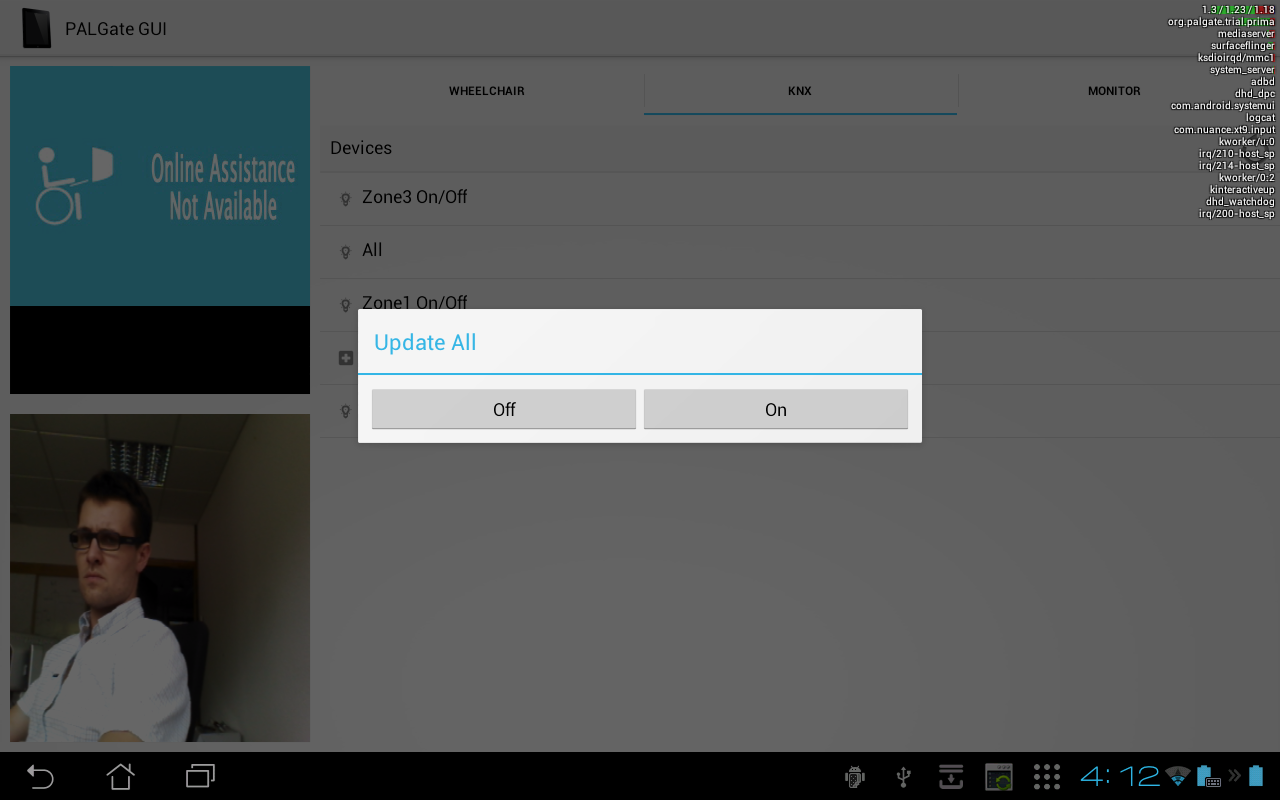

Using ROS for On Road Vehicle Applications
On Road Vehicle Application
Development of perception algorithms to improve car safety
- Platform with lot of sensors (stereo-camera, LIDAR, IMU, GPS, Can, etc.)
- Real Time Processing
- Visualization for demonstration and for analysis
- Recording Terabytes of data for off line experimentations
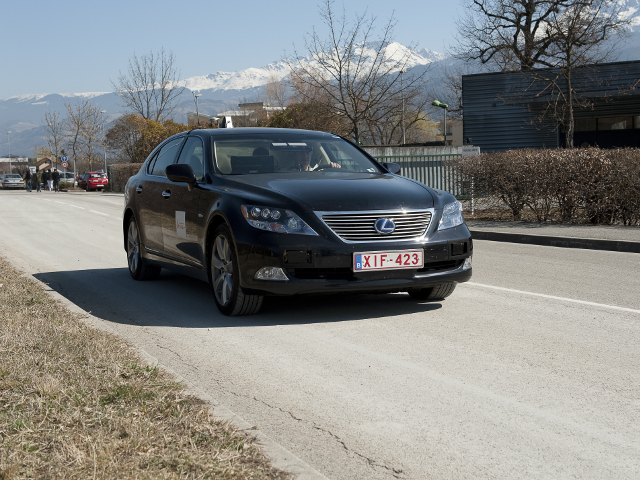

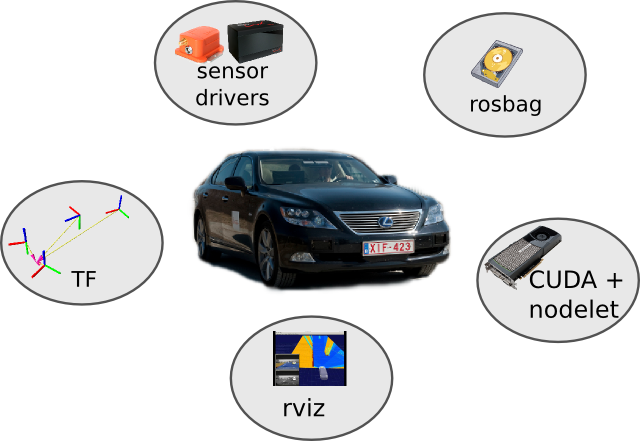
Using ROS for Prototyping Robots
Prototyping Robots
iKio is a sociable device and is fully open source

iKio v0.1 was prototyped out of Bioloids

iKio v0.1 was prototyped out of Bioloids
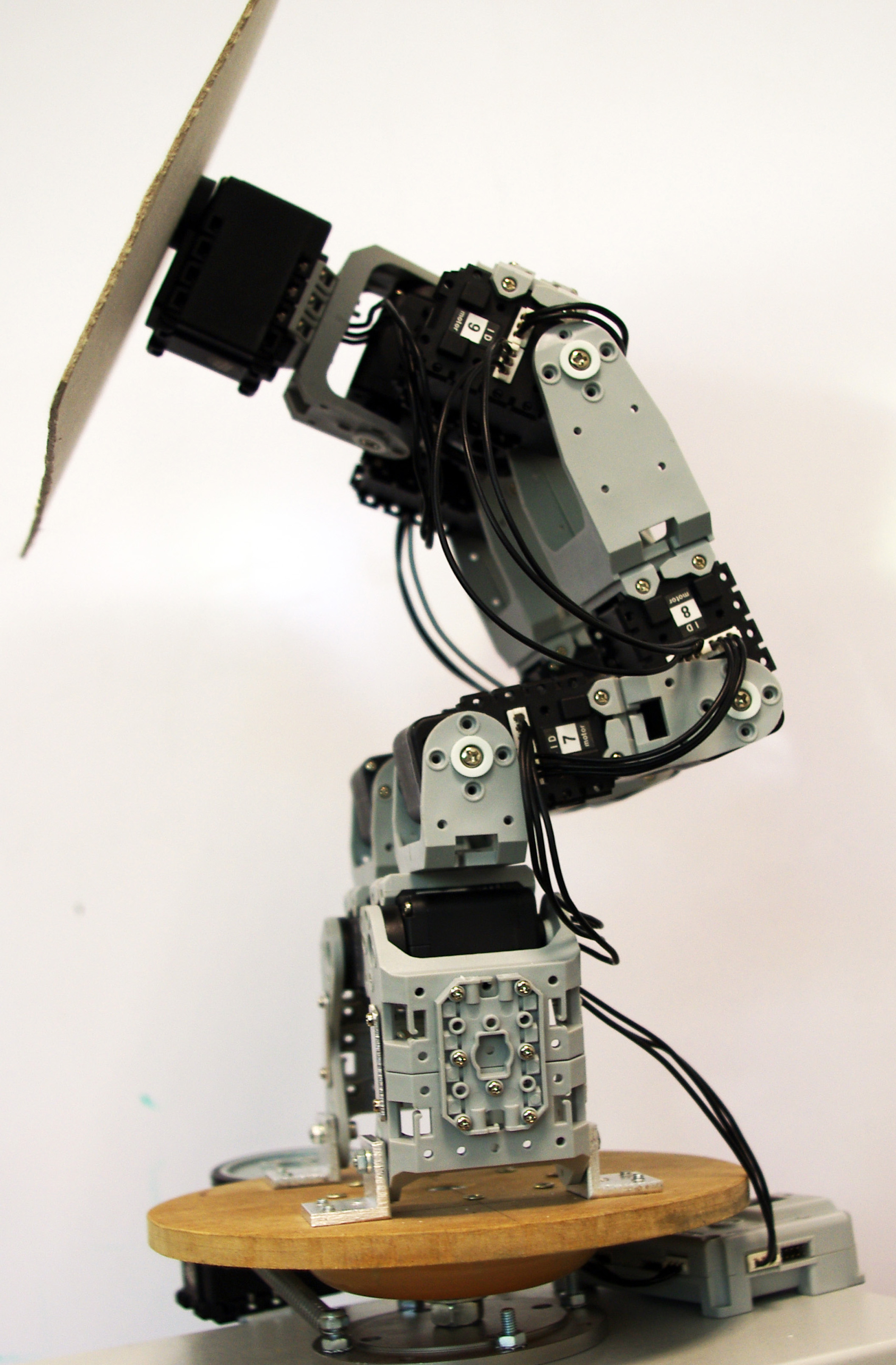
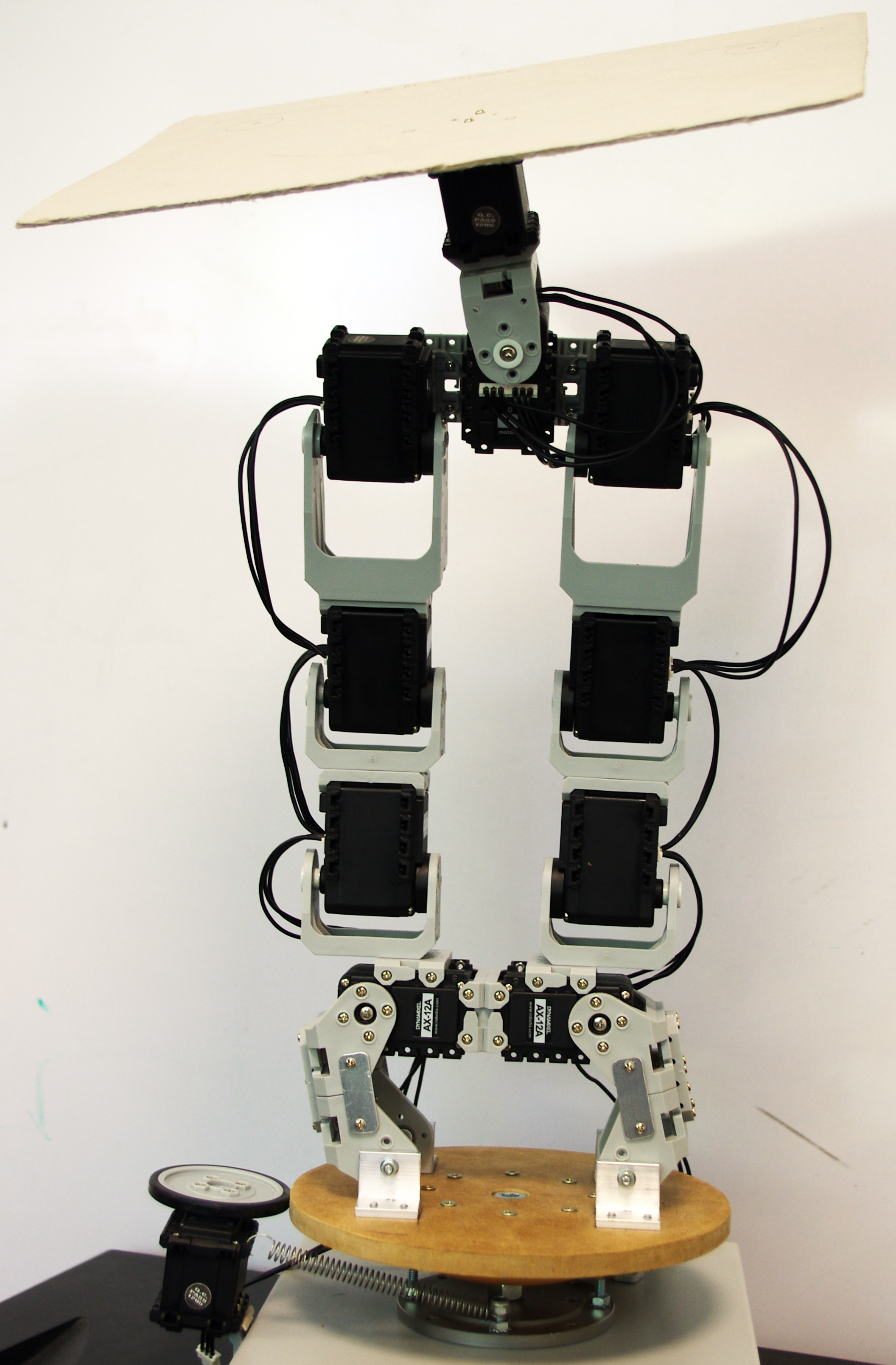
low level control of iKio v0.1 motors is based on BrBrain

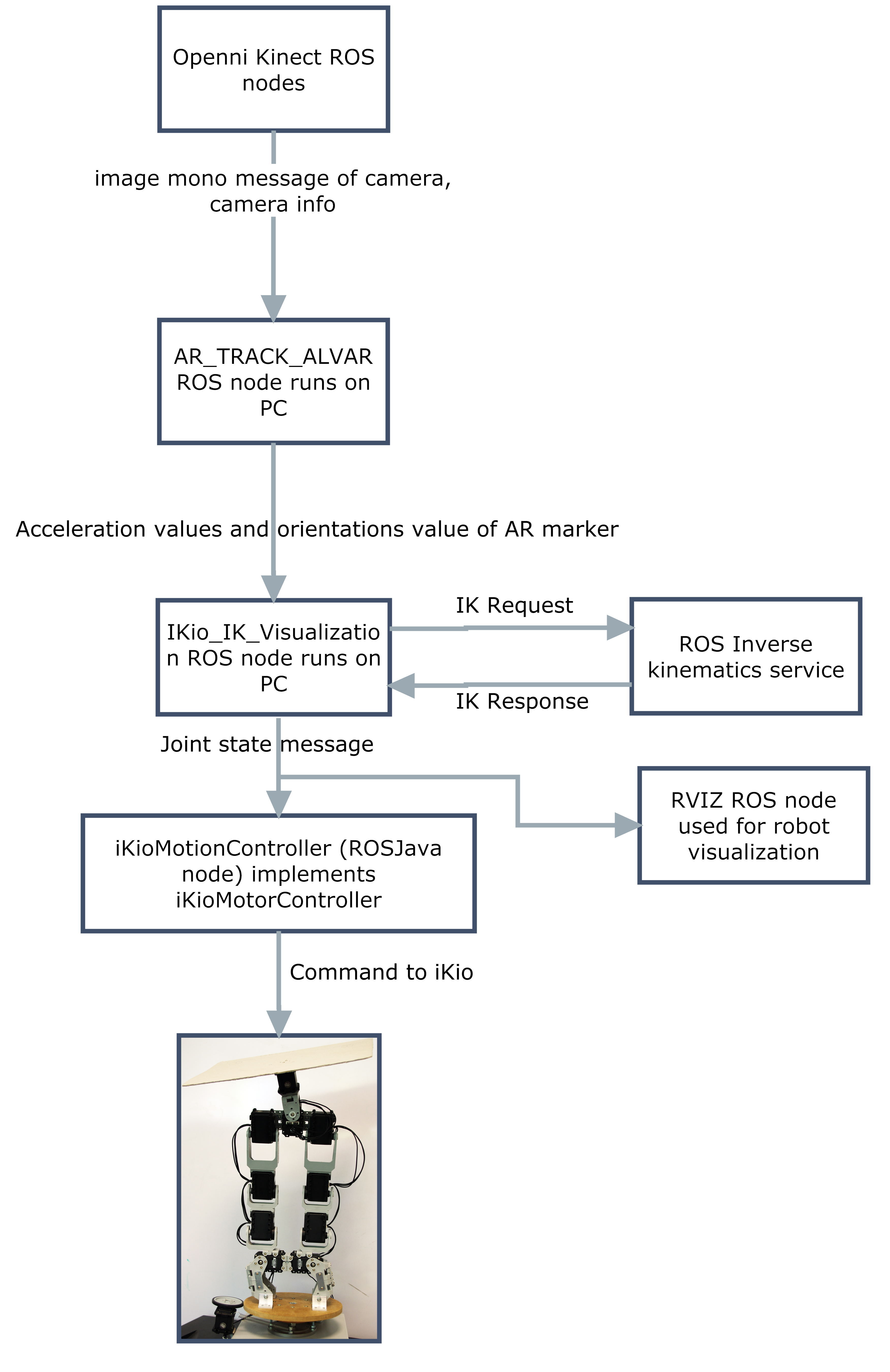
iKio v0.1 kinematic model was expressed using URDF

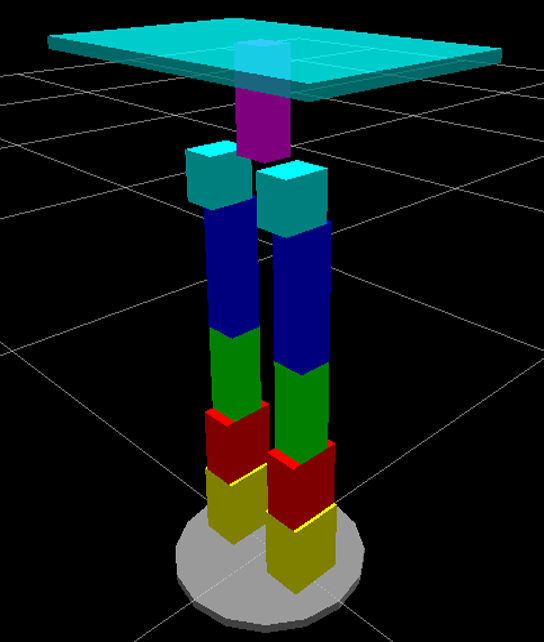

iKio v0.1 early expressions were sketched


iKio v0.1 early expressions were sketched
openni_camera + ar_track_alvar + tf + ik + (rviz) + ikio_motor_controler

Conclusion and Perspectives
- Introduction to ROS
- Getting Started with ROS
- Showcases
- Conclusion and Perspectives
- Live Demonstration

Presentation Wrap up
The objectives of this presentation were
- Introduce you to ROS
- Node, rosmaster, roscore
- Topic, Service
- rostopic, rosmsg, rosservice, rossrv, rospack, rosstack, ...
- rosbag, rxgraph, rviz, tf
- Get you started
- create package and messages
- write publisher/subscriber in c++/python/java
- Illustrate different usages of ROS
- Personally Assisted Living Application http://pal.inria.fr
- On Road Vehicle Application
- Quick prototyping of robot: iKio
- Interact (ask questions, ask for live actions) through a live demo
- be patient...!
Quick Conclusion & Perspectives
ROS is great but ROS community makes it awesome
- ROS provides a powerful infrastructure for developping {robotics} applications
- ROS community provides huge variety of modules (stacks, packages)
ROS is great but can be better
- "ROS is kind of the DOS of component/service oriented middleware"
- Not a state of the art middleware
- Fuzzy concepts (ROS service vs. SOA service? ROS service vs. ROS action, ...)
- Missing dynamic discovery/introspection (dnssd)
- Dynamic/distributed master (maybe no need of master)
- Dynamic discovery of topics, services
- Dynamic introspection/filtering of topics, services
- Dynamic notification/handler
- Not fully cross-platform (please contribute)
- ROS is growing really fast => challenges??
ROS is about YOU, so get ROS and get dirty!
Useful Links
Demonstration
- Introduction to ROS
- Getting Started with ROS
- Showcases
- Conclusion and Perspectives
- Live Demonstration


Thank you
| Rémi Barraquand & Amaury Negre | fOSSa 2012, ROS Framework | Dec 4, 2012 / |